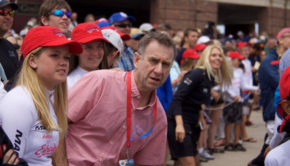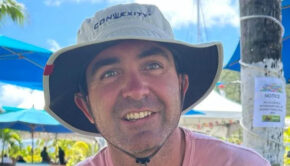Charlie Enright: Ready for the Wild West
Published on January 12th, 2023
The 14th edition of The Ocean Race was originally planned for 2021-22 but was postponed one year due to the pandemic, with the first leg starting on January 15, 2023.
With five IMOCAs racing round the world on the 7-leg course from Spain to Italy, Scuttlebutt editor Craig Leweck checked in with 11th Hour Racing Team skipper Charlie Enright for an update:
While you had to learn how to sail an IMOCA, you also had to assemble a crew. Talk us through that process of creating the sailing team.
It seems like it’s been a long time, leading up to this race when you compare it to what we were expecting. But at the same time, we’re in this IMOCA culture now, which is 20 years strong. So in a way, we’re just still kind of scratching the surface on some of this stuff.
But as I spent time in the class, it became apparent what you needed, which was people with a well-rounded skill set. The days of specificity with huge crews have kind of come and gone. Everybody on the boat basically has to be able to sail it by themselves.
So it’s a different demographic, certainly, than the race has seen in the past, but all the team stuff, if you will, has kind of remained the same. The personalities, the inherent values, all that kind of stuff remains the same. But it’s the physical sailing skills that have kind of changed.
Since the IMOCA is normally sailed solo or doublehanded, even those with more time in the class are having to sort this out too.
I suspect the interpersonal dynamics of going from a single-handed environment to a crewed environment is a bit of a change. But I think if you look at the lowest common denominator– if you could sail a boat around the world alone, chances are you can sail a boat around the world with a couple more people.
A new IMOCA is known to take a long period of time to ramp up. When you’re designing a new boat, you would like to maximize the amount of time to refine the design, but you also need a whole lot of time to maximize its performance. Why does it take so long?
The class itself is on the cutting edge of offshore monohull technology, so a lot of things are being done for the first time, whether it’s foils of a new size or foils period, you name it. I mean, the first person to innovate becomes a bit of a guinea pig.
Plus, it’s not like the America’s Cup where you become a guinea pig in for a set type of inshore conditions off of Barcelona. You’re going into a pretty rugged environment where reliability sometimes trumps performance, and the nuance of getting that balance right is going to be the crux, I think, of The Ocean Race.
In general, the French culture tends to build things light initially, and they kind of commission their boats on a schedule relative to the Vendée Globe, which is held every four years. They start sailing them in Brittany in the summer, and then as the fall approaches and the low-pressure systems get bigger with harsher sailing conditions, you see additional structure and modifications added to the boats.
But if you overbuilt it from inception, that’s structure and weight that you’d actually never get back. Usually, you’re building these boats with a decent lead-up to whatever the premiere event is that you’re focusing on, so that’s kind of baked into it a little bit.
So you wait to find out what’s going to break rather than over-building from inception?
There’s a bit of that, but then there’s also the kind of cutting-edge element of it all. And then there’s the human factor. Some stuff has never been done before. Some stuff is a bit of experimentation. Some stuff, you’ve just got to let the human be the governor.
You’re making a boat that’s capable of achieving performance you never dreamed of, but picking and choosing the times to try to achieve that still come down to the people on board. So it’s a constant risk-reward.
Getting a boat to the finish line is always the goal, and IMOCAs have a little bit more trouble than other classes. Will all five of these boats get to that final finish line in Italy?
That’s the gazillion-dollar question, though if you look at the typical attrition in the fleet, it won’t be easy. To some extent, you’re always trying to hit that sweet spot of reliability versus design. We’d like to think we’re there, but we also know that just the nature of The Ocean Race is a bit like the Wild West, and there’s risk in everything.
I can tell you I’ve been very pleasantly surprised by the attitude of our competitors. The multi-leg experience is new for the French, and they seem to be embracing it. If you have an issue in the Vendée Globe, 9 times out of 10 it’s like, “Oh well, we’ll try again it four years.” There’s not this looming next leg start date, perhaps 30 days down the road. So it seems like everybody’s wrapping their head around that.
I genuinely hope that is the situation and we have five boats at the finish line, but there’s risk in everything. This race is obviously going through a bit of a transition, but think the marriage with the IMOCA class is a very good one. You’d have 40 boats trying to do the Vendée Globe, and there’s a lot of genuine interest in the next edition of The Ocean Race. A lot of people are watching this edition quite closely, and if it takes off as a success, everybody will be very pleased at what the future holds.
Any particular fears for your boat getting to final finish line in Italy?
Everybody, whether they admit it or not, has some kind of fear. For sure, there’s a level of excitement about racing for 35 days in the southern oceans, but a level of trepidation in everybody as well.
In the Vendée Globe, some say it’s a full-on race to Cape Hope and a tacit agreement between the skippers to safely get through the south, and then let loose again from Cape Horn back to France.
I know for a fact that some of the top boats in the Vendée Globe averaged below 70% of their polar performance in the south in the last race. But that’s when the IMOCA has just one person, so what it’s going to look like with four or five people on board pushing these things is a big question mark. Also, will more people onboard be able to push the boats faster? There is still plenty left to learn.
The onboard comfort of an IMOCA is hard to discern from the video, but it is a topic which is increasingly talked about. Is this a growing issue? Are the boats becoming less comfortable?
Oh, for sure. It’s a growing issue. With the advent of the foil, the attitude of the boat changed a tremendous amount, and as the foils have increased in size, it’s got increasingly less comfortable.
Some of the boats are constructed with what they call a monolithic slamming zone in terms of their construction before transitioning into some sort of sandwich construction aft where there’s perceived to be less slamming. And that line, that barrier, as the foils get bigger and they fly more and more and there’s more and more reduced wetted surface, has been going aft and aft and aft to the point where, all of a sudden, you look up and realize, “We’re living in the slamming zone.”
If you could start with a blank sheet of paper, this probably isn’t where you’d end up, but it’s an evolution of a very healthy class over time. But what the future looks like, with rudder elevators, is that going to help? Is it going to smooth it out? Are you really going to fly through the southern oceans on a monohull that’s got such little freeboard? I don’t know.
But it is funny that the likes of some of the French people– no, let’s put it this way, nobody goes from an IMOCA to the 100-foot Ultime and then goes back. Once you get a taste of that comfort and those speeds, and I’ve been fortunate enough to do some sailing on François Gabart’s Ultime, it would be hard to go back.
Another IMOCA evolution is how they are set up to be sailed indoors. How odd is that?
It’s very odd, but when we’re going 25 knots and there’s a ton of water coming in over the deck, you could say it would be ridiculous to be outside in those conditions too. So it’s strange, certainly, but the way the boats are designed and the way the rule is written, they really prioritize low freeboard. Compared to other offshore boats, the IMOCA deck is very close to the water. There’s also the fact that the autopilot is primarily used inside.
Tell us about the autopilot steering system.
The autopilot, certainly in the Anglo-Saxon world, gets a bad rap. People say, “The robot, the artificial intelligence, the computers have taken over.” Yes, there are certain conditions where the pilot does a better job than a human, but the boat’s not designed around trying to have a human driving.
But there’s places where the humans still are irreplaceable, particularly when you’re trying to get the boat to pop. These boats have a performance step function like no other boat I’ve ever seen. It’s like a multihull in that way. You watch SailGP or the America’s Cup, and the difference between displacement and foiling can be 30 knots. For us, it can be 10 knots, but for a boat that’s averaging 25 knots a day, day after day, that’s a big percentage of your speed.
So the human element is not lost at all, even controlling the pilot with what inputs to use. It’s still seat of your pants. You’ve got to feel the boat. Is it healing too much? Is it stuck to the water? Do we need more power? All those sensations that good, fast sailors have in a non-pilot environment are even more relevant when using the pilot.
So it’s interesting. It’s different, certainly, than anything that’s going on elsewhere in the sport and definitely tough to comprehend and wrap your head around if you’re not entrenched in it. But it’s really, really, really good for sailing. It’s awesome.
What percentage of the time are you using the pilot?
We use the pilot over 90% of the time, for sure. When thinking about it in the simplest terms, if you have flat water and a consistent 6 knots and want to hold a straight course, what’s going to drive straighter, a robot or a human? The pilot is typically better, but at the other end of the spectrum, when the boat is lit up and going 25 knots, it’s almost impossible to hand steer with a tiller inside, so the pilot does a better job then too.
But there are these situations where you need to get out there and get the boat to pop and feel the apparent wind. And certainly, with In-Port races and offshore legs starting on a coastal course, there’s hand steering. But the pilot certainly does the lion’s share of the load, though it’s nice to know humans are not totally replaceable yet.
Give us a preview of the first leg from Alicante, Spain to Cabo Verde.
Usually you have pretty good resolution on what the beginning of a leg will be like, but it gets harder to know what’s down the track. However, with Leg 1, it’s almost the opposite right now at four days before the start.
As it’s a bit of a short leg at 1900 nm, and there’s a very well-established high-pressure system in the North Atlantic off the Iberian Peninsula, that section of the leg looks pretty fast and essentially point-and-shoot once you get out of Gibraltar. But what we don’t have good resolution on is the Med.
It looks like there’ll be a frontal passage of some sort with multiple transitions. Gibraltar is primarily water in, but there are tidal elements to it. So based on the transitions, and what time we get there, the first 48 hours look very, very complicated before we lock in and it gets a little bit more traditional and straightforward for what looks to be about a five and a half day leg
As Cabo Verde is often where boats go with boat problems, it will be good to end up in Cabo Verde for a finish. I wish you luck and look forward to catching up with you during The Ocean Race.
Definitely… thanks!
IMOCA: Boat, Design, Skipper, Launch date
• Guyot Environnement – Team Europe (VPLP Verdier); Benjamin Dutreux (FRA)/Robert Stanjek (GER); September 1, 2015
• 11th Hour Racing Team (Guillaume Verdier); Charlie Enright (USA); August 24, 2021
• Holcim-PRB (Guillaume Verdier); Kevin Escoffier (FRA); May 8, 2022
• Team Malizia (VPLP); Boris Herrmann (GER); July 19, 2022
• Biotherm (Guillaume Verdier); Paul Meilhat (FRA); August 31 2022
Race details – Route – Teams – Facebook – YouTube
The Ocean Race 2022-23 Race Schedule:
Alicante, Spain – Leg 1 start: January 15, 2023
Cabo Verde – ETA: January 22; Leg 2 start: January 25
Cape Town, South Africa – ETA: February 9; Leg 3 start: February 26 or 27 (TBC)
Itajaí, Brazil – ETA: April 1; Leg 4 start: April 23
Newport, RI, USA – ETA: May 10; Leg 5 start: May 21
Aarhus, Denmark – ETA: May 30; Leg 6 start: June 8
Kiel, Germany (Fly-By) – June 9
The Hague, The Netherlands – ETA: June 11; Leg 7 start: June 15
Genova, Italy – The Grand Finale – ETA: June 25, 2023; Final In-Port Race: July 1, 2023
The Ocean Race (formerly Volvo Ocean Race and Whitbread Round the World Race) was initially to be raced in two classes of boats: the high-performance, foiling, IMOCA 60 class and the one-design VO65 class which has been used for the last two editions of the race.
However, only the IMOCAs will be racing round the world while the VO65s will race in The Ocean Race VO65 Sprint which competes in Legs 1, 6, and 7 of The Ocean Race course.
Additionally, The Ocean Race also features the In-Port Series with races at seven of the course’s stopover cities around the world which allow local fans to get up close and personal to the teams as they battle it out around a short inshore course.
Although in-port races do not count towards a team’s overall points score, they do play an important part in the overall rankings as the In-Port Race Series standings are used to break any points ties that occur during the race around the world.
The 14th edition of The Ocean Race was originally planned for 2021-22 but was postponed one year due to the pandemic, with the first leg starting on January 15, 2023.









 We’ll keep your information safe.
We’ll keep your information safe.